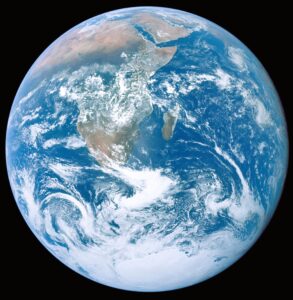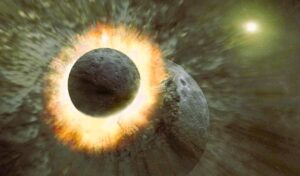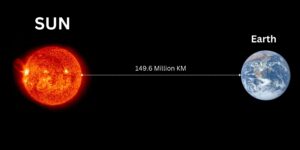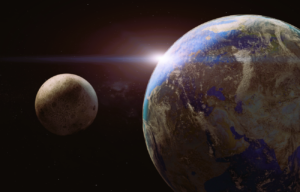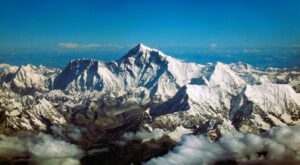- abaashishb7
- April 3, 2024
- 9:33 am
- No Comments
Earth Planet
पृथ्वी ग्रह
* Earth : The Blue Marble In Space
Earth, our home planet, stands as a vibrant oasis in the vastness of space. As the 3rd
No. planet from the Sun in our solar system, Earth holds a unique place as the only
known celestial body to support life. With its stunning landscapes, diverse ecosystems,
and intricate web of life, Our Planet has captivated our curiosity and inspired awe for
millennia. Let’s embark on a journey to explore the wonders of our beautiful planet
* Born
Formation of Earth
1:- Formation of the Solar System: Approximately 4.6 billion years ago, our solar system
began to form from a rotating cloud of dust and gas called the solar nebula. This
nebula collapsed under its gravity, forming a protostar at the center (our Sun) and a
swirling disk of material around it.
2:- Accretion of Planetesimals: Within this protoplanetary disk, tiny dust particles
collided and stuck together, gradually forming larger objects called planetesimals.
These planetesimals continued to collide and accrete, forming larger bodies known
as protoplanets.
3:- Protoplanetary Collision: One of the leading theories for the formation of Earth
involves a giant impact scenario. It is believed that about 4.5 billion years ago, a
Mars-sized protoplanet named Theia collided with the early our planet in a massive
impact event.
4:- Formation of Earth: The collision between Earth and Theia was incredibly
violent, leading to the ejection of a significant amount of material into space. This
material eventually coalesced and accreted to form the Moon, while the remaining
material reformed and cooled to become our planet we know today.
Formation of the Moon (Giant Impact Hypothesis)
1:- Theia Impact: The giant impact with Theia, sometimes referred to as the “Theia
Impact,” resulted in a significant amount of material being ejected into orbit around
our planet.
2:- Formation of a Debris Disk: The ejected material formed a hot, molten debris disk
around our planet. This disk gradually cooled and accreted, forming small moonlets.
3:- Moon Formation: Over time, these moonlets collided and merged to form a larger
object, ultimately becoming the Moon. The material that formed the Moon likely
came from both Theia and the early Earth.
4:- Tidal Forces and Orbit: As the Moon formed, it began to exert gravitational influence
on the Earth. This led to tidal forces that caused the Moon to gradually move away
from Earth and settle into its current orbit.
Key Points
The Moon is made primarily of material from the impactor (Theia) and Earth’s
mantle, but it has a smaller iron core than Earth.
Our Planet’s strong magnetic field is due to its liquid iron-nickel core, which generates a
dynamo effect. The Moon, with its smaller size and lack of a liquid core, does not have a
significant magnetic field.
The Moon’s surface is heavily cratered due to impacts from asteroids and comets. It also
has maria (large, dark plains) formed by ancient volcanic activity.
* Basic Facts about Earth:
1:- Orbital Period: Earth orbits the Sun at an average distance of about 149.6
million kilometers (93 million miles), completing one orbit in approximately 365.25
days, giving us our calendar year.
2:- Rotation: Earth rotates on its axis, completing one full rotation in approximately
24 hours, giving us our day and night cycle.
3:- Size: our world has a diameter of approximately 12,742 kilometers (7,918 miles),
making it the largest of the terrestrial planets (Mercury, Venus, Earth, and Mars) in
our solar system.
4:- Atmosphere: Our Planet’s atmosphere is composed mainly of nitrogen (about 78%)
and oxygen (about 21%), with traces of other gases such as carbon dioxide and argon.
5:- Water: Our Planet is often called the “Blue Planet” because of its vast oceans,
covering about 70% of its surface. Liquid water is essential for life as we know it and
plays a crucial role in our world’s climate and ecosystems.
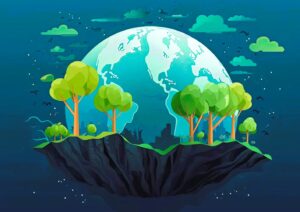
* Life on Earth
1:- Biodiversity: Our Planet is teeming with life, from microscopic organisms to complex
ecosystems. The diversity of life forms on Our World is staggering, with an estimated
8.7 million species, though many more remain undiscovered.
2:- Ecosystems: Our Planet’s diverse ecosystems include forests, grasslands, deserts,
oceans, and more. These ecosystems interact in complex ways to sustain life on our
planet.
3:- Human Impact: In recent centuries, human activity has had a significant impact on
Our Planet’s environment, leading to issues such as climate change, deforestation,
loss of biodiversity, and pollution.
Unique Features of Earth
1:- Magnetic Field: Our Planet has a strong magnetic field generated by its liquid iron-
nickel core, which helps protect the planet from harmful solar radiation and cosmic
rays.
2:- Plate Tectonics: Our Planet’s surface is divided into several rigid plates that float on
the semi-fluid mantle beneath. This movement of plates, known as plate tectonics,
causes earthquakes, volcanic activity, and the formation of mountains.
3:- Seasons: Our Planet experiences seasons due to its axial tilt of about 23.5 degrees.
This tilt causes different parts of the planet to receive varying amounts of sunlight
throughout the year, leading to the cycle of seasons.
4:- Moon: Our Planet has one natural satellite, the Moon, which plays a significant role in
our planet’s tides and has also been a target for human exploration.
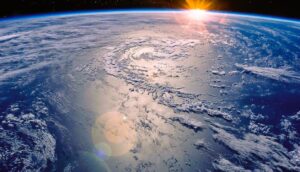
* Earth’s Oceans
The Earth’s oceans are vast, covering about 70% of the planet’s surface. They play a
crucial role in regulating Our Planet climate, providing habitats for countless species,
and supporting life in various forms. Here’s a detailed overview of the Our Planet’s
oceans
1:- Vastness: Our Planet’s oceans cover approximately 361 million square kilometers
(139 million square miles) of the planet’s surface.
2:- Distribution: The oceans are divided into five major basins: the Pacific Ocean,
Atlantic Ocean, Indian Ocean, Southern Ocean, and Arctic Ocean.
Major Oceans
1:- Pacific Ocean:
The largest and deepest ocean, covering about 63.8 million square miles
(165.25 million square kilometers). It is bordered by Asia and Australia to the west
and the Americas to the east.
2:- Atlantic Ocean:
The second-largest ocean, covering approximately 41.1 million square miles (106.5
million square kilometers). It is bordered by Europe and Africa to the east and the
Americas to the west.
3:- Indian Ocean:
The third-largest ocean, covering about 27.2 million square miles (70.6 million
square kilometers). It is bordered by Africa to the west, Asia to the north, Australia to
the east, and the Southern Ocean to the south.
4:- Southern Ocean (Antarctic Ocean):
The fourth-largest ocean, though not officially recognized by all countries. It
surrounds Antarctica and is characterized by strong currents and cold temperatures.
5:- Arctic Ocean:
The smallest and shallowest ocean, covering approximately 5.4 million square miles
(14 million square kilometers). It is located around the North Pole and is covered by
ice for much of the year.
* Mountains’
1:- Mount Everest (Nepal/Tibet):
Height: 8,848 meters (29,029 feet)
Location: The highest peak on our planet, located in the Himalayas on the border of
Nepal and Tibet.
Significance: Mount Everest is the tallest mountain in the world, attracting climbers
from around the globe seeking to reach its summit.
2:- K2 (Pakistan/China):
Height: 8,611 meters (28,251 feet)
Location: The second-highest peak in the world, part of the Karakoram Range on the
Pakistan-China border.
Significance: Known for its challenging and dangerous climbing conditions, often
referred to as the “Savage Mountain.”
3:- Kangchenjunga (India/Nepal):
Height: 8,586 meters (28,169 feet)
Location: The third-highest peak in the world, located in the Himalayas on the border
of India and Nepal.
Significance: Kangchenjunga is revered by the local Sikkimese people and is known
for its stunning beauty.
4:- Lhotse (Nepal/Tibet):
Height: 8,516 meters (27,940 feet)
Location: Adjacent to Mount Everest in the Himalayas, part of the Everest massif.
Significance: Lhotse is the fourth-highest peak in the world and shares a close
association with Mount Everest.
5:- Makalu (Nepal/Tibet):
Height: 8,485 meters (27,838 feet)
Location: Located southeast of Mount Everest in the Himalayas.
Significance: Makalu is known for its striking pyramid shape and challenging
climbing routes.
6:- Cho Oyu (Nepal/Tibet):
Height: 8,188 meters (26,864 feet)
Location: Part of the Himalayas, located on the Nepal-Tibet border.
Significance: Cho Oyu is the sixth-highest mountain in the world and is popular
among climbers for its relatively less technical ascent compared to other peaks.
7:- Dhaulagiri (Nepal):
Height: 8,167 meters (26,795 feet)
Location: Located in the Himalayas of Nepal.
Significance: Dhaulagiri is the seventh-highest mountain in the world and is known
for its steep slopes and challenging climbing routes.
8:- Manaslu (Nepal):
Height: 8,163 meters (26,781 feet)
Location: Located in the Himalayas of Nepal.
Significance: Manaslu is the eighth-highest mountain in the world and is renowned
for its stunning vistas and challenging climbs.
9:- Nanga Parbat (Pakistan):
Height: 8,126 meters (26,660 feet)
Location: Located in the western Himalayas of Pakistan.
Significance: Known as the “Killer Mountain” due to its treacherous climbing
conditions and high fatality rate among climbers.
10:- Annapurna (Nepal):
Height: 8,091 meters (26,545 feet)
Location: Located in the Himalayas of Nepal.
Significance: Annapurna is a massif comprising several peaks, with Annapurna I
being the highest. It is known for its challenging climbs and beautiful scenery.
* Composition of Earth
Inner Core
1:- Depth: Extends from the center of our planet to a depth of about 1,220 kilometers
(758 miles).
2:- State: The innermost layer of our planet, the inner core, is solid due to the immense
pressure despite high temperatures.
3:- Composition: Composed mainly of solid iron and nickel, with temperatures
reaching up to 5,700 degrees Celsius (10,300 degrees Fahrenheit).
Outer Core
1:- Depth: Extends from the outer boundary of the inner core to a depth of about 2,900
kilometers (1,800 miles).
2:- State: The outer core is the only liquid layer of our planet.
3:- Composition: Composed of molten iron and nickel, with temperatures ranging from
4,000 to 5,000 degrees Celsius (7,200 to 9,000 degrees Fahrenheit).
4:- Magnetic Field: The flow of molten iron in the outer core generates Our Planet’s
magnetic field through a process called the geodynamo effect.
Mantle
1:- Depth: Extends from the outer core to a depth of about 2,900 kilometers (1,800
miles) to 2,891 kilometers (1,796 miles) below our planet’s surface.
2:- State: The mantle is solid but behaves like a plastic or semi-fluid due to high
temperatures and pressures.
3:- Composition: Composed mainly of silicate minerals rich in iron and magnesium.
4:- Upper Mantle: Extends to a depth of about 670 kilometers (420 miles) below the
surface. The upper mantle contains minerals such as olivine, pyroxene, and garnet.
5:- Transition Zone: Located between the upper and lower mantle, this region
experiences changes in mineral structure due to pressure and temperature.
6:- Lower Mantle: Extends from about 670 kilometers (420 miles) to 2,891 kilometers
(1,796 miles) below the surface. Composed of high-density materials like perovskite
under tremendous pressure.
Crust
1:- Depth: Our Planet’s crust varies in thickness, with oceanic crust being thinner (about
5-10 kilometers or 3-6 miles) and continental crust thicker (about 30-50 kilometers
or 20-30 miles).
2:- State: Our Planet’s crust is solid and brittle.
3:- Composition: Composed primarily of lighter elements such as oxygen, silicon,
aluminum, and iron.
4:- Oceanic Crust: Rich in basaltic rocks, primarily found beneath the oceans.
5:- Continental Crust: Rich in granitic rocks, forming the continents and landmasses.
Lithosphere
1:- Depth: Includes our planet’s crust and the uppermost part of the mantle, extending to
a depth of about 100 kilometers (60 miles) below the surface.
2:- State: The lithosphere is solid and rigid.
3:- Composition: Composed of the Our Planet’s crust and the uppermost part of the
mantle.
4:- Tectonic Plates: The lithosphere is divided into several large and small tectonic
plates that float on the semi-fluid asthenosphere below.
Asthenosphere
1:- Depth: Extends from about 100 kilometers (60 miles) to 660 kilometers (410 miles)
below the surface.
2:- State: The asthenosphere is semi-fluid and behaves like a plastic due to high
temperatures and pressures.
3:- Composition: Composed of partially molten rock that allows for the movement of
tectonic plates.
Atmosphere
1:- Depth: Extending from Our Planet’s surface outward.
2:- State: The atmosphere is a gaseous layer surrounding Our Planet.
3:- Composition: Composed mainly of nitrogen (about 78%) and oxygen (about 21%),
with traces of other gases such as argon, carbon dioxide, and water vapor.
4:- Layers: The atmosphere is divided into several layers, including the troposphere,
stratosphere, mesosphere, thermosphere, and exosphere.
Hydrosphere
1:- Depth: Our Planet’s hydrosphere includes all water on the planet, including oceans,
lakes, rivers, glaciers, and groundwater.
2:- State: Water exists in various states—liquid, solid (ice), and gas (water vapor).
3:- Composition: The oceans contain mainly saltwater (sodium chloride and other salts),
while freshwater is found in glaciers, ice caps, rivers, lakes, and groundwater.
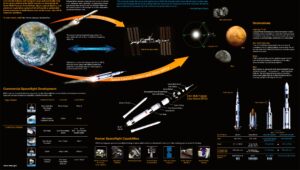
* Modern Exploration
Remote Sensing
1:- Satellite Technology: Satellites equipped with various sensors and instruments orbit
our planet, providing valuable data on climate, weather patterns, land use, vegetation
cover, and more.
2:- Applications: Remote sensing data is used for monitoring deforestation, tracking
changes in sea levels, studying atmospheric composition, mapping urban growth,
and Assessing natural disasters.
Climate Studies
1:- Climate Models: Advanced computer models simulate Our Planet’s climate system,
incorporating data from satellites, weather stations, ocean buoys, and more.
2:- Understanding Climate Change: Scientists study past climate records in ice cores,
tree rings, and sediment layers to understand the causes and impacts of climate
change.
Ocean Exploration
1:- Deep-Sea Research: Submersibles and remotely operated vehicles (ROVs) explore
the ocean depths, discovering new species, studying underwater ecosystems, and
mapping underwater terrain.
2:- Ocean Currents and Climate: Research vessels measure ocean currents and
temperatures to understand their role in climate regulation and the distribution of
marine life.
Biodiversity and Conservation
1:- Biological Surveys: Scientists conduct biodiversity surveys in forests, oceans, and
other ecosystems to catalog species and assess their populations.
2:- Conservation Efforts: Monitoring endangered species, establishing protected areas,
and combating illegal wildlife trade are key focuses of modern conservation efforts.
Geological Exploration
1:- Seismic Studies: Seismometers record earthquakes and reveal Our Planet’s internal
structure. This data helps us understand plate tectonics, volcano monitoring, and
earthquake prediction.
2:- Mineral Exploration: Advanced techniques like satellite imagery and geophysical
surveys aid in the discovery of mineral deposits and sustainable resource
management.
Space-Based Exploration
1:- Missions to Other Planets: NASA’s Mars rovers and probes explore the geology and
potential for life on Mars.
2:- Lunar Exploration: Space agencies like NASA and private companies are planning
manned and unmanned missions to the Moon for scientific research and potential
resource extraction.
Urban Monitoring
1:- Urbanization Mapping: Satellite data and aerial imagery are used to monitor urban
growth, analyze infrastructure, and plan sustainable cities.
2:- Air Quality Monitoring: Sensors in cities measure air pollution levels and help
policymakers improve air quality.
Disaster Management
1:- Early Warning Systems: Earthquake and tsunami early warning systems use real-
time data to alert at-risk populations.
2:- Emergency Response: Satellite imagery assists in disaster response by providing
damage assessment, locating survivors, and coordinating relief efforts.
Our Planet, with its diverse ecosystems, vast oceans, and protective atmosphere, is a
unique and precious jewel in our solar system. It is the only known planet to support life,
making it a truly remarkable place in the universe.
As we continue to study and explore our home planet, we gain a deeper understanding
of its interconnected systems and the delicate balance that supports life. Protecting and
preserving Our Planet’s environment is crucial for the well-being of all species, including
our own.
- abaashishb7
- April 3, 2024
- 9:33 am
- No Comments


